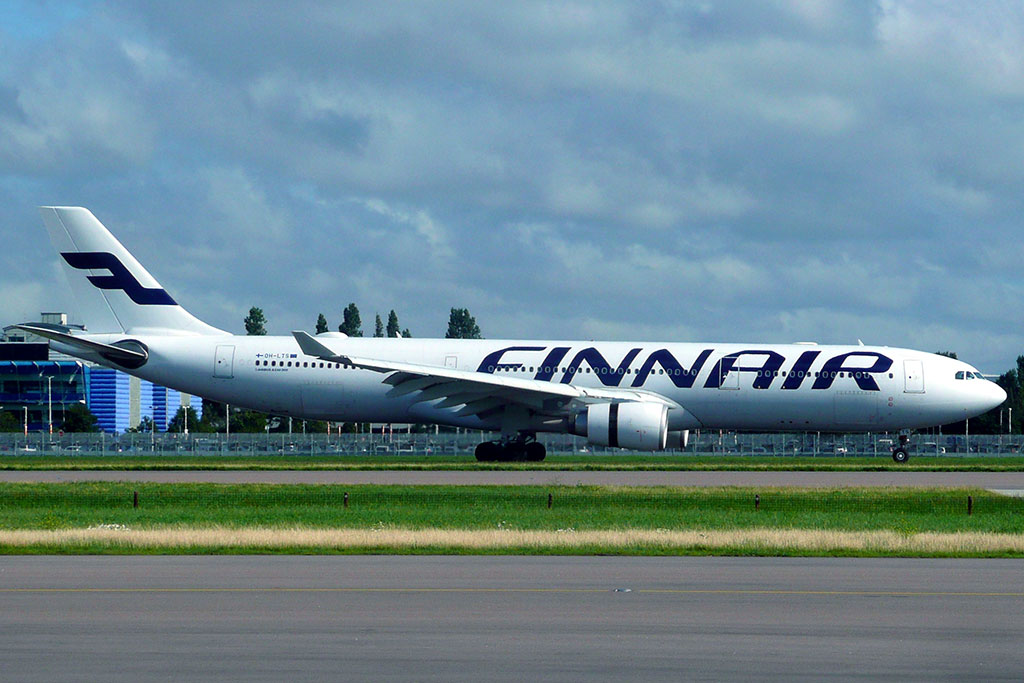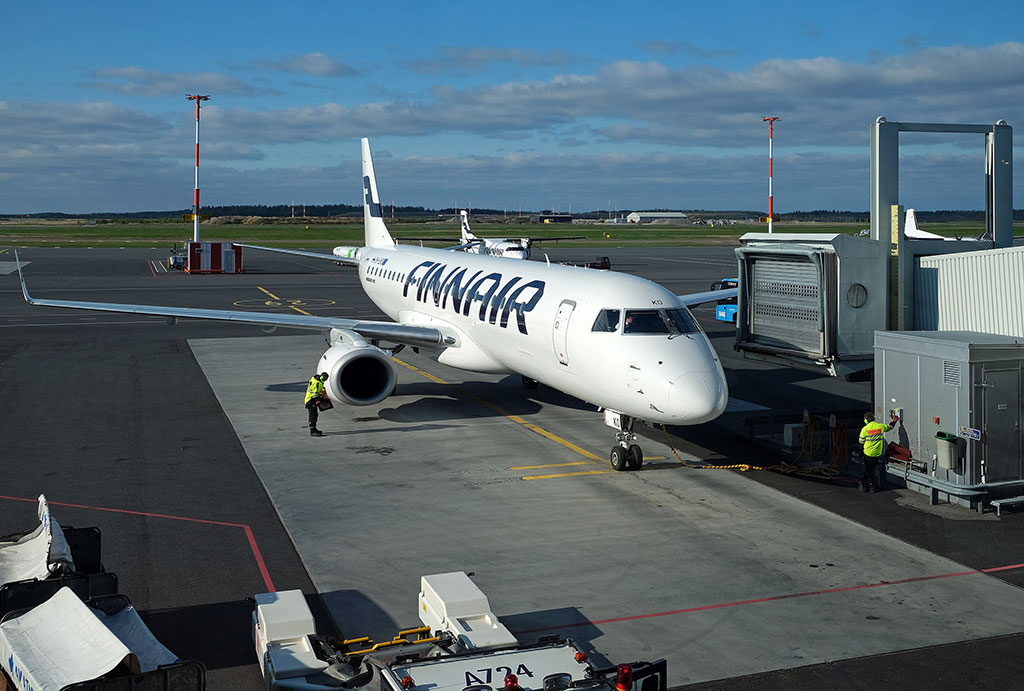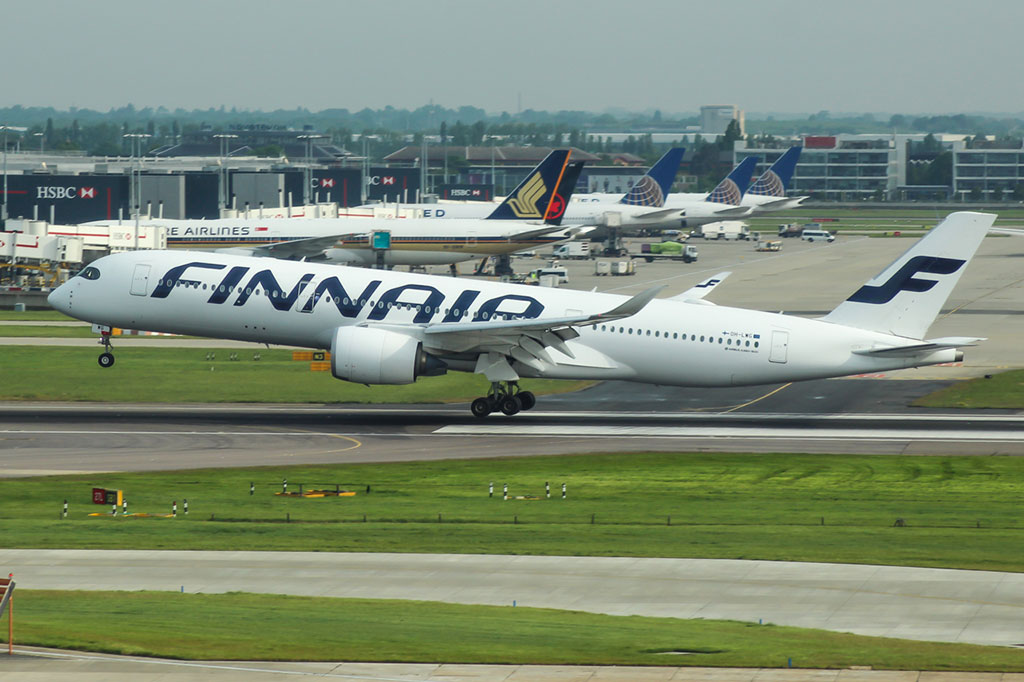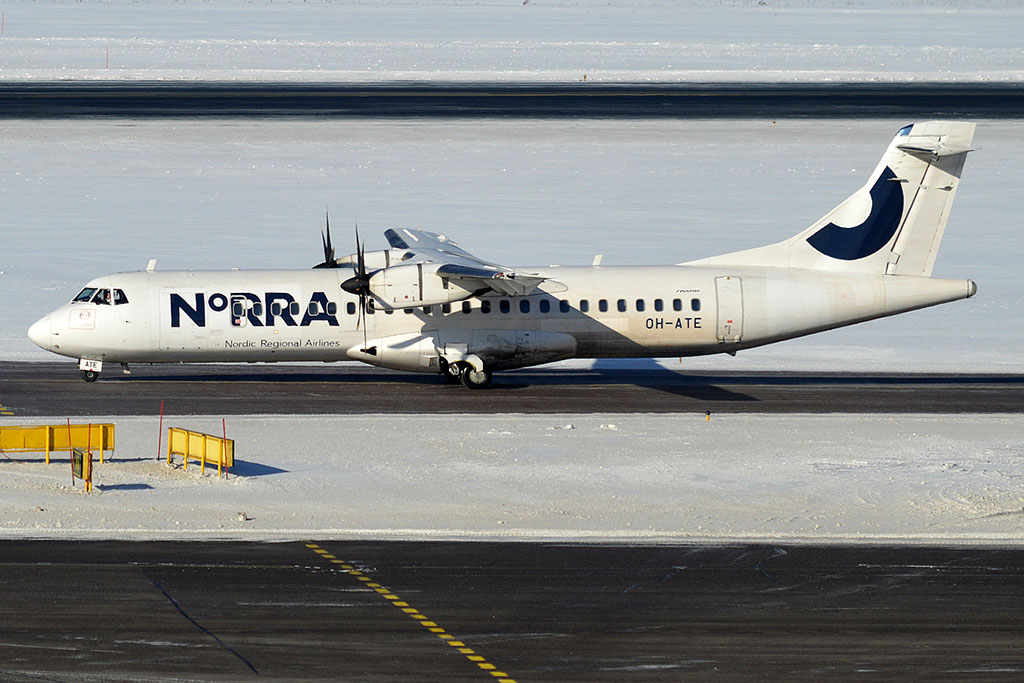Finnair, the national airline of Finland, has almost 100 years of continuous operation, making it the sixth oldest airline in the world. Here’s a profile of its history and current fleet.
Finnair History

The inaugural Finnair flight between Helsinki and London on the 1 September 1954, operated by a Convair CV-340, OH-LRA. (Finnair.com in Wikimedia Commons)
Finnair was founded on the 1 November 1923 as Aero O/Y (Aero Ltd) and commenced operations in March 1924 using a Junkers F.13 on a flight from Helsinki to Tallinn, Estonia. The single-engine F.13 was equipped with floats during the summer months on services from Helsinki to Tallinn (extended to Berlin from 1925) and Stockholm, and skis in the winter months for internal flights.
A Junkers G.24 was added to the fleet in June 1926 and, by 1928, three more Junkers F.13 had been acquired, largely as a result of the 50% share Junkers Flugzeugwerke AG had in the new airline at the time. In the same year, Aero O/Y introduced the ‘Scandinavian Air Express’, linking Tallinn and Helsinki to London and Paris. Stops at Stockholm, Malmo, Copenhagen and Amsterdam were included in the twenty-four hour end-to-end route.
The next few years saw several new routes added to the airline’s network together with the introduction of an airmail service. To support such growth, a Junkers Ju 52/3m was added to the fleet in June 1932. By 1936 airports had been built at Turku and Helsinki ending the use of seaplane services in December of that year. The conversion to an all-landplane fleet led to the acquisition of two de-Havilland Rapides to operate a number of domestic routes from May 1937 until the outbreak of the Second World War. Most civil operations came to an end during the war, although a service between Helsinki and Stockholm continued through to the winter of 1944.
Domestic services soon resumed after the end of the war, using a fleet of war-surplus Douglas C-47s converted to the civilian equivalent DC-3, and the international Helsinki-Stockholm service recommenced in November 1947.

A Convair CV-440, OH-LRF. Finnair operated Convair CV-40s from 1952 through to the late 1970s. (SDASM Archives)
As the airline continued to expand and carry an increasing number of passengers, three Convair CV-340s were added to the fleet in 1952, quickly followed by the more advanced Convair CV-440 Metropolitan, with both types taking over the international routes. In 1953 the airline introduced the Finnair brand on its aircraft and advertising materials, although it wasn’t until June 1968 when Finnair introduced a new logo that the name change became official. New international services from Helsinki to Paris in October 1953, to London Heathrow in September 1954 and to Moscow in February 1956 were introduced using the Convairs, while the number of domestic routes, mainly served by the DC-3s, continued to increase. With the rapidly expanding airline on the verge of exceeding its fleet capacity, the company ordered its first passenger jet aircraft in January 1958, three Sud Aviation SE210 Caravelles. The first aircraft was delivered in February 1960 and went into service on routes to Stockholm and Frankfurt, followed soon after by other international routes, including London Heathrow. A fourth Caravelle – a more powerful Caravelle III – was delivered in February 1964 and the first three Caravelles in the fleet were later upgraded to this improved variant. Finnair went on to acquire eight Super Caravelle 10B3s between 1964 and 1967, with jet airliners now flying almost 95% of the airline’s scheduled routes.

Sud Aviation SE210 Super Caravelle, OH-LSB, at Heathrow in July 1972. (Steve Fitzgerald, distributed under a Creative Commons GNU FDL 1.2 Licence)
In preparation for the start of transatlantic services, Finnair received the first of two Douglas DC-8-62CF aircraft in February 1969. Flights from Helsinki to New York, via Copenhagen and Amsterdam, began in May 1969. Further expansion and modernisation of the fleet continued with the arrival of the first Douglas DC-9-10 in January 1971. By 1983 a further eight of the same type had been acquired, together with several of the larger DC-9-40. In addition, delivery of twelve DC-9-50s, the largest version of the first generation of DC-9s to enter airline service, began in 1976. Towards the end of the 1970s, Finnair’s Convairs were coming to the end of their lifespan but, rather than replacing them with jet aircraft, Finnair opted for the Fokker F-27-200 Friendship, employing three on short domestic routes until the retirement of the type in 1988 and its replacement by ATR 42-200s.

Douglas DC-9-50, OH-LYN. The DC-9-50 was the largest of the first generation DC-9 family to be used by airlines. Finnair took delivery of twelve of the variant from 1976, as well as operating DC-9-10s and DC-9-40s. (Tim Rees, distributed under a Creative Commons GNU FDL 1.2 Licence)
The first of two McDonnell Douglas DC-10-30s was delivered to Finnair in February 1975; the first wide-body aircraft to be used by the airline. The aircraft was initially deployed between Helsinki and Las Palmas before being used on transatlantic flights to New York from 27 March 1975. New routes to Seattle and Los Angeles were introduced in 1981 and in 1983 Finnair operated the first non-stop flight from Western Europe to Japan, using a modified DC-10-30ER from Helsinki to Tokyo.

From April 1983 the DC-9 Super 82 replaced the older DC-9-50 on most European routes and in the same year the Super Caravelle was finally withdrawn from the fleet after almost twenty-three years of service. Several McDonnell Douglas MD-83 aircraft joined the fleet in June 1985 to be used on scheduled domestic and European flights. Thirteen MD-83s were eventually delivered to Finnair and remained in service until 2006, together with eight MD-87s which were acquired between 1987 and 1991 and used predominantly on European routes until 2001. Fleet modernisation continued with the arrival of Finnair’s first Airbus aircraft, the A300B4-203 in 1986, followed by a second A300 in March 1987. These aircraft were initially loaned to Finnair’s subsidiary, Karair, and deployed on holiday charter flights.

McDonnell Douglas MD-83, OH-LMG. Finnair operated the type between 1985 and 2006. (JetPix, distributed under a GFDL 1.2 Licence)
Finnair became the first Western European airline to fly non-stop to China in 1988 with the launch of its Helsinki to Beijing route, adding to its already established link to south-east Asia through a Helsinki to Singapore via Bangkok service.
In December 1990 Finnair was the launch customer for the McDonnell Douglas MD-11, with its inaugural flight from Helsinki to Tenerife, but by the early 1990s the economic recession had started to impact the airline. In an attempt to remain profitable Finnair started to replace its DC-9s with used MD-80s, thus reducing the number of aircraft types it operated. However, twelve DC-9s were retained and retrofitted with hush kits in 1998 for noise reduction in the proximity of airports.

Boeing 757-200, OH-LBT, on final approach to Helsinki Airport in 2005 (Antti Havukainen, distributed under a Creative Commons CC BY-SA 3.0 Licence)
In 1996, two other Finnish airlines, Karair and Finnaviation, were merged into Finnair. Further fleet changes involved the leasing of two Boeing 757-200s in 1997 for use on charter leisure flights, followed by a further two in 1998.
By 1998 customer demand had once more increased and Finnair carried nearly 4 million passengers that year. Helsinki remained the main hub, although a second hub had been opened in Stockholm. Finnair joined the Oneworld Alliance in December 1999, which brought about the use of joint operational facilities and savings on ground service costs, purchasing and marketing.

The first of the Airbus A320 family aircraft to be acquired by Finnair in 1999 was the A321-200 series. Shown here at Heathrow in June 2010 is A321 OH-LZB which was delivered to Finnair in March 1999. (Aero Icarus, distributed under a Creative Commons CC BY-SA 2.0 Licence)
The first Airbus A321-200 entered service with Finnair in February 1999, followed by an Airbus A319-100 in September of the same year. As the number of these aircraft in the fleet increased, DC-9s and MD-80s were slowly phased out as part of a fleet overhaul. Further orders for A320 family aircraft were placed in 2000 as the demand for international business travel increased significantly. Finnair’s first Airbus A320-200s went into service early in 2001, but a sudden downturn in Finnair’s profitability occurred later that year following the terrorist attacks in the US.
Despite some recovery in 2002, further challenges for air travel followed with the SARS epidemic and the war in Iraq. Nevertheless, Finnair carried more than eight million passengers in 2004. Finnair had now received all twenty-nine Airbus A320 family aircraft from its initial order and continued to develop the fleet with an order for eight Embraer E170-100s to replace the remaining MD-80 and ATR72-200 aircraft. Delivery of the E170s took place between September 2005 and November 2006.

Airbus A330-300, OH-LTS, at Heathrow in August 2017. (John Taggart, distributed under a Creative Commons CC BY-SA 2.0 Licence)
The long-haul fleet was the next to be upgraded. In late 2005 Finnair announced plans to gradually replace its MD-11s with three Airbus A340-300s and nine Airbus A350-900s by 2021. The first aircraft, a pre-owned A340, was acquired in July 2006, followed by two more in 2007. In addition, the long-haul fleet was supplemented by the arrival of five Airbus A330-300s during 2009, primarily for use on Asian routes. As a consequence, the last MD-11 was withdrawn from passenger service in 2010 after twenty years of service by the type.
During 2010 Finnair began to withdraw some of its fleet of seven Boeing 757-200s, to be replaced in time by the Airbus A321ER (Extended Range), the first of which was delivered in 2013 with Finnair as the launch customer. The final two remaining Boeing 757s were withdrawn in early 2014. Withdrawal of the E170s from service also started in 2010.
As for most of the airline industry, the period from 2008 to 2011 was particularly challenging financially for Finnair. Despite this, the airline returned to profitability in 2012. There was a slight downturn in growth the following year which led to Finnair entering into sale and leaseback arrangements for new A321 and A350 aircraft and for some owned A330s. Following an expansion drive by the Oneworld Alliance in 2014 and Finnair’s entering into joint business arrangements with British Airways and Japan Airlines to provide expanded schedules and connections, Finnair ordered eight additional A350 aircraft, increasing its A350 order to nineteen. As part of the order Airbus agreed to take four A340-300 aircraft from Finnair. Further sale and leaseback deals for six ATR72-500s, three Embraer E190s and two A350s (still on order) were agreed to help finance the acquisition of the new A350s.
Finnair’s first A350 was finally delivered in October 2015 and entered into service on the Helsinki to Shanghai route. In 2017 Finnair carried almost twelve million passengers. The airline decided to retain its A330s and also acquired additional A321s for short-haul flights. However, the A340 was phased out, with the last A340 flight at the end of January 2017.
During 2019 Finnair planned to further increase its Asian business and proceeded to invest in fleet expansion to achieve this. Unfortunately, the COVID19 pandemic severely impacted on these plans. During 2020 Finnair transported only 3.5 million passengers (14.7% of pre-COVID passenger numbers) and made a loss of £507 million. In response to the financial challenges, the airline delayed the delivery of three A350s to 2022-2025 and retired several of its older A319 aircraft.
Finnair currently has a fleet of 80 aircraft in service, including: Airbus A319-100 (6), Airbus A320-200 (10), Airbus A321-200ER (15), Airbus A330-300 (8), Airbus A350-900 (17), Embraer E190LR (12) and ATR72-500 (12) which are leased to Nordic Regional Airlines (Norra) and operate domestic and European flights on behalf of Finnair.
Base/Hub

Embraer E190LR, OH-LKO, at Helsinki-Vantaa Airport. (kallerna, distributed under a Creative Commons CC BY-SA 4.0 Licence)
Helsinki-Vantaa Airport
Current Finnair Fleet
Embraer E190LR
| OH-LKE | OH-LKF | OH-LKG | OH-LKH |
| OH-LKI | OH-LKK | OH-LKL | OG-LKM |
| OH-LKN | OH-LKO | OH-LKP | OH-LKR |
Airbus A319-100
| OH-LVC | OH-LVD | OH-LVH | OH-LVI |
| OH-LVK | OH-LVL |
Airbus A320-214
| OH-LXA | OH-LXB | OH-LXC | OH-LXD |
| OH-LXF | OH-LXH | OH-LXI | OH-LXK |
| OH-LXL | OH-LXM |
Airbus A321-231

Airbus A321-200, OH-LZH on final approach to Heathrow in August 2017. (Photo: Nigel Richardson)
| OH-LZE | OH-LZF | OH-LZG | OG-LZH |
| OH-LZI | OH-LZK | OH-LZL | OH-LZM |
| OH-LZN | OH-LZO | OH-LZP | OH-LZR |
| OH-LZS | OH-LZT | OH-LZU |
Airbus A330-300
| OH-LTM | OH-LTN | OH-LTO | OH-LTP |
| OH-LTR | OH-LTS | OH-LTT | OH-LTU |
Airbus A350-941

The newest addition to Finnair’s fleet is the Airbus A350-900. Pictured here is A350-900 OH-LWG departing Heathrow for Helsinki in July 2018. (Mark Harkin, distributed under a Creative Commons CC BY-2.0 Licence)
| OH-LWA | OH-LWB | OH-LWC | OH-LWD |
| OH-LWE | OH-LWF | OH-LWG | OH-LWH |
| OH-LWI | OH-LWK | OH-LWL | OH-LWM |
| OH-LWN | OH-LWO | OH-LWP | OH-LWR |
| OH-LWS |
ATR72-500 (operated by Nordic Regional Airlines)

ATR72-500, OH-ATE, operating for Nordic Regional Airlines (Anna Zvereva, distributed under a Creative Commons CC BY-SA 2.0 Licence)
| OH-ATE | OH-ATF | OH-ATG | OH-ATH |
| OH-ATI | OH-ATJ | OH-ATK | OH-ATL |
| OH-ATM | OH-ATN | OH-ATO | OH-ATP |





1 comment
Finnair also had EMB-110 Bandeirantes.